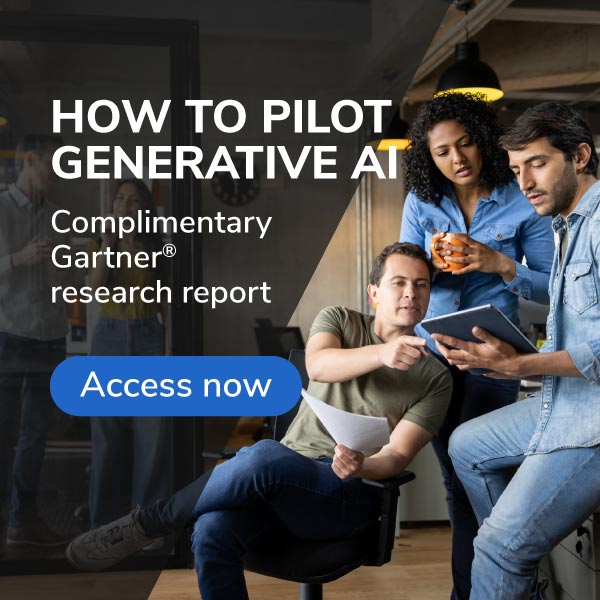In 2017, we saw both an increase in public cloud adoption as well as a rise in media attention to security breaches. The good news is, GCP is leading the way in cloud security. While leading cloud providers boast relatively clean security records and impressive uptime, the public’s hyperfocus on application security will drive cloud adopters towards hybrid cloud environments, secure and tightly controlled applications, and container orchestration platforms that automate compliance policy. Simultaneously, cloud competitors will continue to move towards lighting fast serverless offerings that support the influx of IoT devices beaming back big data from your knick-knacks around the house, all the way from egg trays to cookie ovens.
Here are the top 5 tech considerations paving the path towards leading cloud solutions like GCP:
1: Hybrid/Multi-Cloud
At this point, we can agree that cloud is not a fad, but the future of how companies will run their business applications. Our customers are beginning to leverage the cloud to help supplement some of the limitations and hardships of running their own datacenter. Some customers have found that GCP’s resiliency and high availability makes it the perfect platform as a disaster recovery site. Some recognize the sheer size and speed of Google’s network and leverage this backbone to serve application data to end users all over the world with lower latency. Even those who need their datacenter locally to leverage low latency and high performance compute can find benefit for spikes in workload by sending these bursts to the cloud to supplement their own resources. The New York Times has taken this methodology of adopting a multi-cloud environment to help scale and diversify their technology offering by leveraging AWS for its corporate applications, and GCP for customer-facing applications. No matter the customer, there is something to be gained by leveraging one (or multiple) clouds to take advantage of the sheer power of compute that is readily available with a few clicks of the mouse.
2: Serverless Era
We have come a long way since the physical bare metal days of computing, where a single host would be responsible for a single server. When virtualization became widespread, we were able to share resources between hosts, create standby snapshot instances, and spin up these abstracted servers in a matter of minutes. When cloud came out on the scene, these same virtual machines could be up and running within seconds. Today, many companies are moving further away from time managing an operating system and beginning to utilize containers to easily move and scale their applications on any server. As we move further up the stack and away from managing underlying components, we can now focus on what it is that makes our applications run: code. No longer do we need to focus on the hardware needed for a server, the OS, the network, or how many or where our end users are.
What’s the secret sauce behind serverless? Containers. But where this becomes instrumental is by moving ourselves away from managing the orchestration of these nodes. By leveraging serverless computing in App Engine, GCP once again handles all of the backend management for you. The cost of entry for this infrastructure would be cost prohibitive for most who wanted to create a quality application. With serverless computing, an application can boast enterprise-grade performance with little to no barriers when confronted with cost.
3: IoT/IoE
We are nearing the age of the Cyborg. Man has already met Machine, so becoming one might be the natural next step in this of Internet of Things era we are knee deep in. No longer is it only FitBits and Apple Watches dominating the IoT spectrum of wearables, Louis Vuitton has jumped on the bandwagon with its partnership with Android. Forrester expects 12 million smartwatches in the US by the end of 2018 alone. Another unique opportunity arose for another luxury brand this year. Ralph Lauren triumphs with a wearable win as it supplies America’s Winter Olympics team with heat-controlled uniforms for their chilly ceremonies in PyeongChang, South Korea. Other examples are in the automotive industry, from Lyft’s self-driving car taking the public streets of Boston already and BMW’s announcement of a Tesla competitor battery. And then there is the most popular IoT example, the most popular holiday devices sold on Amazon this past holiday season: Alexa and its competitor: Google Home. It truly is an ever-connected world, with the Internet of Things or Internet of Everything claiming namesake to this industry. These devices will not be on the center stage for long. More recently, the plethora of data and analytics that are created from these devices have come from the shadows. For many companies, a business tool to collect and then analyze this data has been making its way to the top of the list. Examples like BigQuery from GCP are starting to gain popularity amongst data fanatics.
4: Security
Not much seems to be safe anymore. The 5th largest data security breach occurred in 2017 with Equifax compromising nearly 50% of Americans. Yahoo has had at least 4 billion user accounts hacked since 2014. NSA tools have been leaked. The Russians took advantage of Twitter bots to affect the US election. Even the largest cloud storage solution (AWS) was hacked and 200 million voter records were exposed. So how on earth can we make the right decisions for our technology if nothing seems to be safe? A good rule of thumb seems to be not to put all your eggs in one basket. If you store your data on AWS S3, also storing it on GCP Cloud Storage or on-prem could be a safe bet. As already mentioned, the movement toward multi-cloud and hybrid-cloud environments are on the up and up. Consistently loading your security stack with the best is the only option that should be considered at this point. The industry leaders like Google, Cisco, and Microsoft are doing the work for you these days. Google of course uses GCP, so you can trust they will do everything to protect themselves and you. As unsafe as everything is these days, awareness is top-notch because of it. Trust the companies who have a stake in your security and don’t put all your eggs in a single basket anymore. Oh, and freeze your credit. Thanks Equifax!
5: Containerization
Last year, we witnessed a major mainstream rise (not just early adopter hype) in the adoption of service-oriented architecture built upon containers. Monolithic applications will be ashamed to show face in 2018 where separately deployable microservices can scale and communicate in seamless harmony. With Google’s Kubernetes paving the way, more targeted container orchestration offerings built on top of it are soon to follow. As companies continue to migrate to and mature into containerized environments, there will be increased demand for usability, re-usability and application level security. Ease of deployment, scalability and communication between services will attract the final laggards into this new age of containers – most notably privacy-conscious financial institutions and healthcare organizations.
It’s Not Too Late to Join the Fun with GCP
If you still work at a company where a mysterious smoke can sometimes be seen seeping in from the server room, it’s worth walking down the hall to IT and discussing the jump to cloud. Consider SADA’s Google Cloud Platform solutions, GCP is faster, more secure, and more flexible – oh, and much less disconcerting than those erratic on-premise servers.


Seth Moffitt – Google Cloud Platform ISE
Kyla Hunts – Google Cloud Platform ISE


